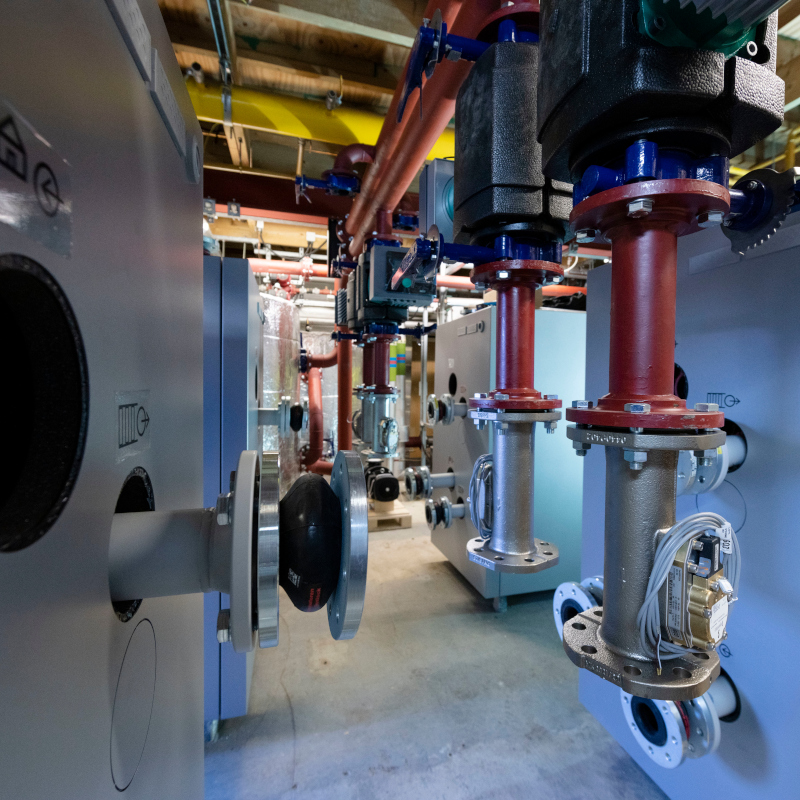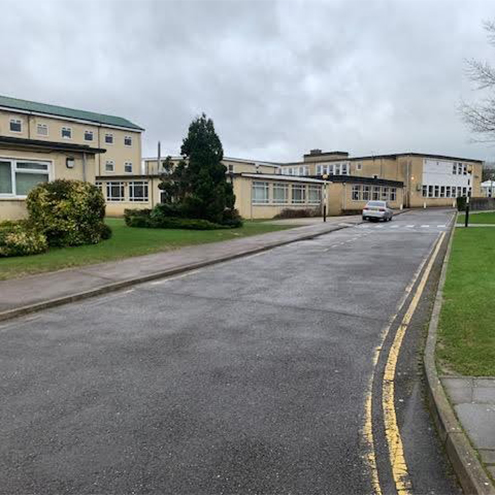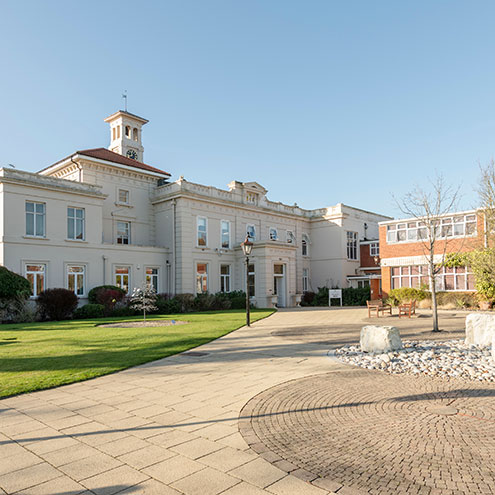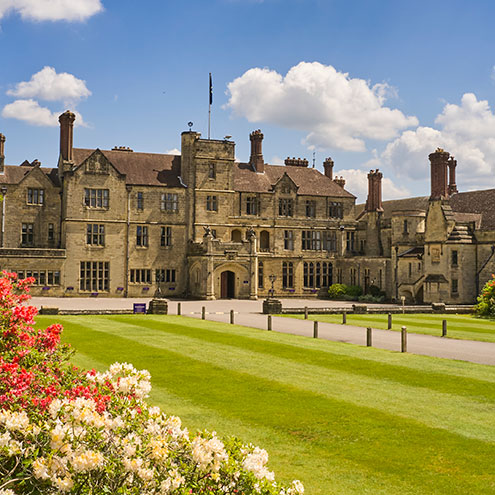Here are some examples of ReEnergise work for Schools:
Securing Public Sector Grants for Heat Decarbonisation
What needs to be done
To decarbonise a school estate the following tasks must be completed for each school site:
1. Planning. Develop what is known as a Heat Decarbonisation Plan (HDP) for each school. The HDP identifies, explains and plans in detail:
a. The energy efficiency works required.
b. The heating plant conversion works required, including design concept.
c. The required implementation programme, costs (capex / opex), business case, grant funding, and any other resourcing for conversion of each school site.
2. Capital Works. Complete all the capital works enshrined in the relevant school HDP.
Grant funding
Annual public sector grant funding is available to cover most of this work: it would not be affordable without it. ReEnergise provides technical and commercial support to clients applying for these grants. We do so free of charge, on the understanding that if the application is successful then we will be awarded the work.
The grant funding is controlled by Salix Finance on behalf of DESNZ. The Low Carbon Skills Fund (LCSF) is available to pay for the development of HDPs. The Public Sector Decarbonisation Scheme (PSDS) pays for the bulk of the resulting capital works. The LCSF runs each spring and the PSDS in the autumn: the thinking is that applicants can sequence their grants for the planning and implementation programme within the same year, if needs be.
In practice this is challenging: both grant schemes are allocated competitively across the public sector throughout England, and historically they have been heavily over-subscribed. For the LCSF, correctly completed applications are drawn at random by Salix: so there is little that can be done to increase an applicant’s chances, except to ensure that the application form has been completed correctly. However, for the PSDS, applications are graded according to the ratio of carbon emissions saved compared to the cost of the capital works (known as grant carbon cost). Once graded, applications are then prioritised in 3 tiers and then drawn at random within each tier: but the top tier (lowest grant carbon cost) gets the priority. This is a sensible way for DESNZ to ensure value for money, as it favours those projects that will achieve the most carbon reduction in relative terms.
ReEnergise success with grant funding
ReEnergise has been exceptionally successful with the PSDS. We have supported clients across every round of PSDS funding and maintained a 100% success rate with education sector applications to date, including applications for 6 grants totalling over £4M this time around. This is no accident. It reflects our careful scrutiny of the mechanics of the PSDS, a strong focus on grant carbon cost when developing decarbonisation plans and grant applications, and our care and attention in guiding our clients through this nuanced process.
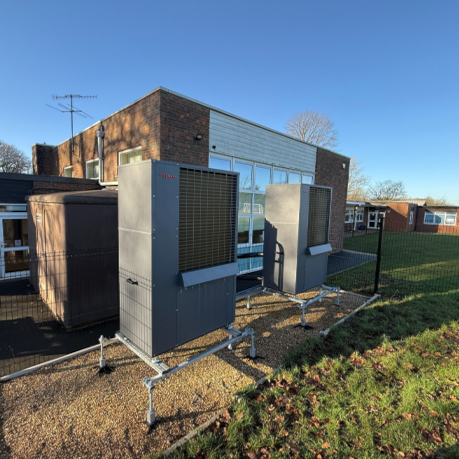
Air Source Heat Pumps installed
Diocese of Guildford Schools
Work done:
- In 2021, working jointly with the Diocesan Board of Education staff, developed a strategy for the decarbonisation of the diocesan schools.
- Then provided technical and commercial support for an LCSF Phase 2 grant application to fund decarbonisation plans for 41 schools, that being the first phase of the strategy.
- The grant application was successful and ReEnergise was appointed to develop decarbonisation plans for the 41 schools, in a relatively tight timeframe from November 2021 to March 2022, March 2022 being the grant drawdown deadline set by Salix.
- In 2022, again working jointly with Diocesan staff, developed a strategy for implementation of the plans, which prioritised interventions across the 41 school sites and enabled the Diocese to decide how to proceed with implementation.
- Provided technical and commercial support for a PSDS Phase 3B grant application to fund the decarbonisation and energy efficiency programme for the highest priority school sites, that being the next phase of the strategy.
- The grant application was again successful. From April 2023 to the present, ReEnergise has been appointed as Project Manager and Project Engineer for a 2-year energy efficiency and decarbonisation programme
Benefits to Client:
- In some ways the key benefit was enabling the Diocese to secure the required grants. Without these, neither decarbonisation planning nor the related capital works would have been possible at the rate required to meet the overall Diocesan targets.
- The Diocese has benefited from consistent, high-quality advice and support across the full range of the components of a decarbonisation programme, including initial advice, the development of design concepts for each site, project definition, detailed design, tendering for contractors and the subsequent project management and engineering scrutiny of contractor work.
- The Diocese now has a roadmap and established methodology for achieving net-zero across its school estate in line with Church of England and Diocesan targets.
- The first tranche of schools has been converted which is expected to reduce CO2 emissions by 466.97 tCO2e per year and cut annual energy usage by 1,779,556.30 kWh, resulting in a 70.07% reduction in total annual energy consumption(kWh).
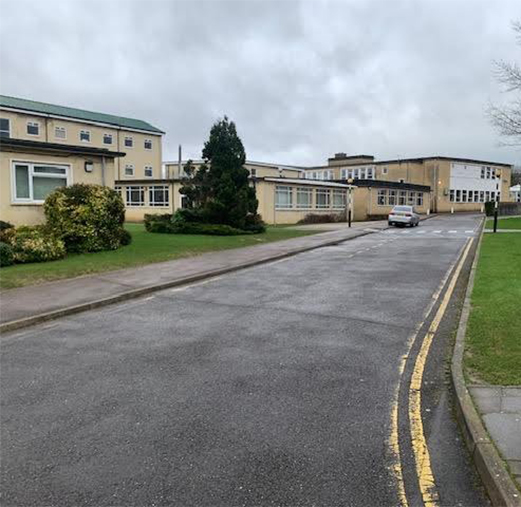
The Corsham School
Work Done:
- Heat decarbonisation plan completed (senior and junior schools).
- Project managed the installation of 2 x 350kW biomass boilers serving district heating system at the senior school site.
- Managed the drawdown of the Public Sector Decarbonisation Scheme (PSDS) grant with Salix Finance.
- Project-managed energy efficiency upgrades, including insulation and LED lighting as well as the upgrade of the domestic hot water supply in two blocks of the school.
- Necessary planning amendments made successfully with no delay to the project.
Benefits to Client:
- The scheme is expected to save 30 tCO2e a year and save £4,199,164 in fuel costs alone over 25 years.
- The school’s heating is now considered net-zero in all sections of the school where the biomass boilers supply heat.
- As part of the works, upgrades to the existing distribution system were made and areas of asbestos were removed.
- The energy centre was made sub-surface, with the boilers and fuel store below ground to minimise the building profile in a heavily used residential area: this made planning approval easier.
- Heat main trenched across the school fields to ensure that access to school buildings was not disrupted and the trenching for the heat main was completed during the school summer holidays.
- Delivered the project under budget.
- The project didn’t have any period of down time for heating at the school: this was essential, as the switch over from gas to biomass happened in the peak of winter.

Affordable net-zero by 2043
Haileybury
Work done:
- Over the course of 8 months, we developed a net-zero strategy and estate decarbonisation plan (EDP) for Haileybury that showed how the college could achieve net-zero by 2043.
- The EDP established a year by year roadmap to estate net-zero, starting with energy efficiencies, solar and windpower for distributed (on-site) generation, and leading ultimately to heat decarbonisation, the latter being the key to achieving net-zero carbon.
- Workshops and monthly steering meetings ensured transparency and engagement at every step.
- ReEnergise know-how and experience working with schools and colleges meant that we could quickly identify the key issues and avoid wasting time on dead-ends.
Benefits to Client:
- Haileybury staff now have a credible net-zero target date and understand the future financial commitments required to reach it.
- The roadmap is affordable: it has been carefully constructed to meet the annual cashflow constraints set by the college.
- In the early years the plan focuses on reducing energy usage and operating costs significantly, saving money that can be used to finance the more expensive main heat decarbonisation projects later in the 20-year programme. The plan shows how to cut grid electricity by 70% in the first 5 years.
- The early cost-cutting work will not jeopardise the eventual achievement of net-zero: the plan achieves unity of purpose over the next 20 years, until the job is done.
- The plan can be efficiently updated as required, in the light of new developments or data.
- The plan serves as a common reference point and guide for the entire college community.
- The Haileybury partnership with ReEnergise continues, as we support the implementation of the roadmap.
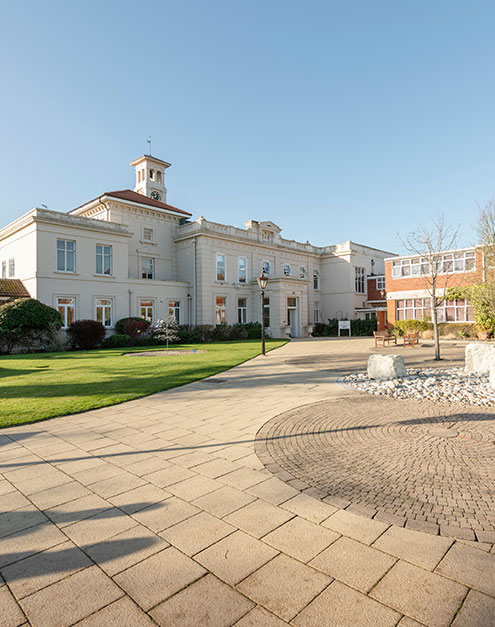
St George’s College
Work done:
- Initial decarbonisation plan to determine the preferred design concept, including associated costings and business case modelling.
- Tendering to identify the right installers and put required contracts in place for the college.
- Project-managed the installation of a 132-borehole ground array feeding 4 x 222 kW ground source heat pumps in an adapted existing plant room.
- New heat pumps serve an existing district heat network to 4 buildings with capacity to connect to a further three, thereby supplying the whole core of the
college. - Prefabrication of key components ensured higher quality whilst minimising on-site disruption.
- Work completed within a demanding timescale, including disruptions during lockdowns, to meet a Government subsidy deadline that was critical to the
business case.
Ground Source Heat Pump Installation at St George’s College, Weybridge
Benefits to Client:
- Worked closely with college staff to ensure decarbonisation plans were in-line with the college’s wider net-zero goals.
- Carbon emissions reduced by ~250 tonnes of CO2e per year.
- The system can provide cooling as well as heating. This will be significant in summer, when the buildings have historically had overheating issues.
- Futureproofed against a reliance on fossil fuels.

Worth School and Abbey
Work done:
- Initial decarbonisation plan to determine the preferred design concept, including associated costings and business case modelling.
- Tendering to identify the right installers and put required contracts in place.
- Project-managed the replacement of old oil boilers with a 1.6MW biomass district heat network to Worth School and Worth Abbey (24 buildings with a network extending over 1.7km), with LPG back-up.
- Installation of a remote monitoring system to allow for heat usage tracking and billing purposes.
- Futureproofed the project by providing a tee-off point in the network, to supply a sports centre currently in the initial design phase.
- Working closely with estate staff, coordinated a programme of extensive trenching work around the estate, including during term time, to minimise disruption to normal business. This required weekly meetings and a rolling 3-week look-ahead to be kept up to date and published around the school and abbey.
- Kept installer contract variations below 3%, from the initial contract.
- Programme completed within a demanding timescale, including disruptions during lockdowns, to meet a Government subsidy deadline that was critical to the business case.
Benefits to Client:
- Carbon emissions reduced by ~940 tonnes of CO2e per annum.
- Estate successfully off oil before an anticipated Government deadline to start phasing out oil plant (2024 at the time the project was launched).
- The system is saving money compared to the counter-factual.

The founder – Thomas Sutton
Charterhouse School
Work done:
- Condition survey of all M&E assets (over 1000 items of plant and associated equipment).
- Decarbonisation strategy and plan (over 70 buildings entailed).
- Prime contractor for 230kW solar PV project.
- VAT review & energy account validation, bringing immediate reduction in operating costs, plus rebates on past and current accounts.
- Energy procurement support, including online auction to reduce supply costs.
- Energy supply demand and capacity assessment for estate expansion purposes.
- Ad hoc M&E advice as required.
- Estate water strategy.
- Tutorial on energy account management for estate staff.
Benefits to Client:
- Financial. E.g. significant rebates on past energy accounts and savings on energy procurement.
- Operational. E.g. holding a working database of all M&E assets indicating data such as location, type, fitness for role, state of repair, priority for replacement, and likely costs will speed up planning and maintenance work.
- Climate change. E.g. The estate decarbonisation plan provides a useful roadmap for future projects that will accelerate the intended transition to net zero-carbon, whilst the installation of solar PV at scale will reduce the estate’s carbon footprint in a practical sense.

Drilling rig for the GSHP boreholes at Sherborne Girls
Sherborne Girls School
Work done:
- Decarbonisation strategy and plan.
- Prime contractor for design and installation of a 180kW GSHP for new Arts Centre.
- Client’s consulting engineer for two solar projects.
- Analysis of feasibility for estate-wide biomass system (deemed unviable) and Combined Heat & Power.
- ESOS audits.
- Research, scoping and installation of live/real-time energy monitoring & management system; with termly reports on energy usage observations.
Benefits to Client:
- A comprehensive index of potential money and carbon saving projects now exists, ranked by cost versus benefit, and full of useful advice on each option.
- Net benefit on solar projects of over £350,000 over 20 years.
- ESOS compliance.
- Anomalies in day to day energy usage can now be identified quickly.
- Arts Centre GSHP is cost-neutral with mains gas, but reduces carbon footprint by 75%, and provides concurrent heating and cooling in different parts of the building – all from the one system. Clever!

Westbourne House School
Westbourne House School
Work done:
- Assessed unsolicited proposals received from various renewables installers, as part of an overall energy efficiency audit. We modelled the proposals and demonstrated, mathematically, that they would not achieve what the client hoped for.
- Project-managed a combined solar PV/thermal installation on the swimming pool roof.
- Scope for a more innovative project now under review, including using a nearby lake to provide the source for a water source heat pump that will heat a new build.
Benefits to Client:
- Avoided wasting a lot of money on an inappropriate low-carbon solution for heating the estate (which is already on mains gas).
- Solar installation projected to achieve a net benefit of £120,000 in running costs over the 20-year period modelled. Payback is 7 years.
Estate Decarbonisation Plans
These days it all starts with an Estate Decarbonisation Plan (EDP). So what work does this entail?
Through the EDP development process, ReEnergise investigates the means for a client school to fully decarbonise its estate heat, power and transport, using the existing situation as a base case for comparison.
Heat is the main driver, as it creates most of the typical school estate’s carbon emissions and its decarbonisation is entirely within the gift of, and totally dependent upon, the school’s actions. Heat decarbonisation is also the most difficult, disruptive and expensive aspect of estate decarbonisation, so must be given due priority in planning.
Transport creates much fewer direct emissions and the route to decarbonisation is almost inevitably electrification.
Before a plan for the future of estate power can be developed it is necessary to understand not only existing demand and options for efficiencies, but also the additional demand created by the plans for future heat and transport decarbonisation.
National Grid has a Government target to decarbonise the UK power grid by 2035, therefore once the provision of power to the school estate matches the future demand, no further power decarbonisation work will be necessary if decarbonisation is the only goal, even if the supply is still entirely from the grid.
However, independent power generation or storage on a school estate could still provide a financial advantage, as well as enhancing security of supply, and is therefore also considered as part of the EDP study.
To be most effective and efficient, heat, power and transport should be treated as one integrated system. This is a complex development process that can only be achieved by tackling it using the methodology described above.
Pulling all this together, the EDP will set out a multi-year plan to implement this integrated system. The EDP can be amended and adjusted as progress, circumstances and technological developments dictate, but will ensure that any actions taken are aligned with the overall objective.
This degree of planning for the future has become a key and necessary undertaking for any school wishing to become net-zero sooner or later.
In recent months and years ReEnergise has been engaged to develop decarbonisation plans, or higher level strategies, for a wide range of schools and colleges. The list below shows those already submitted to client schools, or under development:
- Aysgarth School
- Beaudesert Park School
- Berkshire College of Agriculture
- Methodist Independent Schools Trust – 7 schools so far, with 3 more pending
- Diocese of Guildford – 41 schools
- Diocese of St Albans – 3 schools
- Edgeborough School
- Felsted School
- Haileybury
- Hawthorne Park Community Primary School
- Hockerill Anglo-European College
- Horris Hill School
- Kingston Maurward College
- Lime Academy Trust – 7 schools
- Tendring College
- Tennyson Road Primary School (North & South Campuses)
- The Corsham School
- The Rugby Group
- The Stowe Group
- Yeovil College
The pipeline for new orders remains strong.

